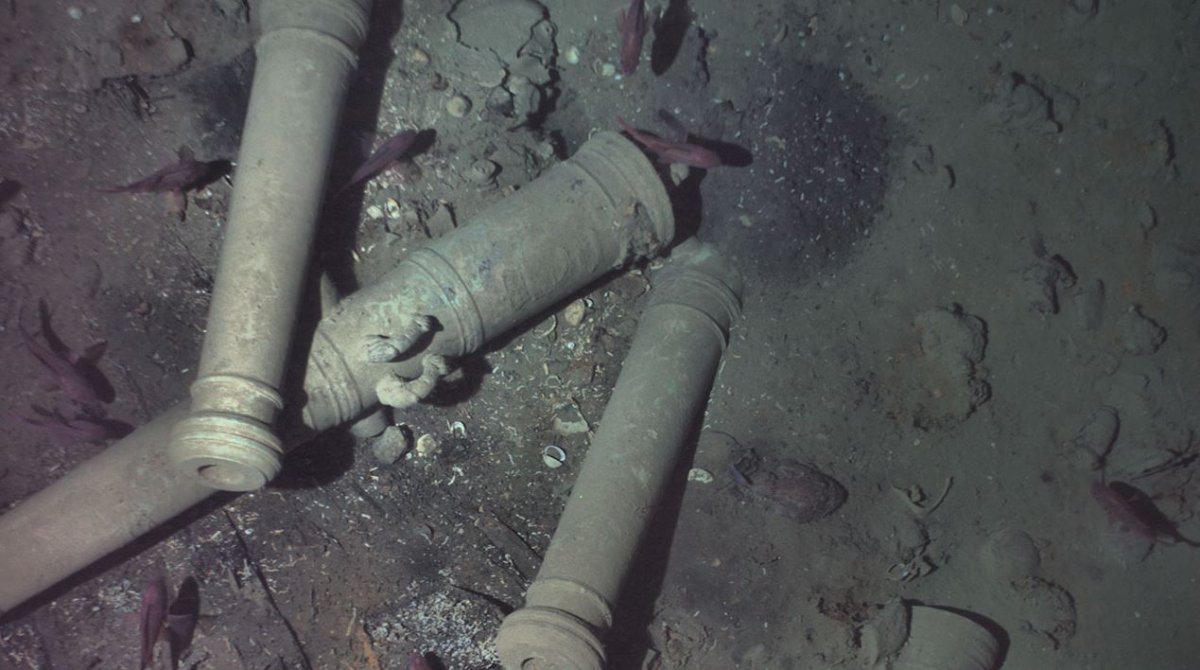In 1708, a Spanish galleon carrying 600 people and laden with gold, silver and emeralds—thought to be worth as much as $17 billion by today's standards—was sunk by British ships during a battle off the coast of Cartagena, Colombia.
More than 300 years later in November 2015, the San José, which is often referred to as the "holy grail of shipwrecks," was discovered by an international team of scientists and engineers in collaboration with the Colombian Navy.
On Monday, the Woods Hole Oceanographic Institution (WHOI) and Maritime Archaeology Consultants (MAC), who both helped to find the wreck, released the first information describing how exactly the galleon was found. Up until this point, many aspects of the discovery have been covered up out of respect for the Colombian government, which is keeping the exact location of the wreck a secret.
This is because Colombian authorities are worried that other parties will try to claim the treasure for themselves, given its enormous value. In fact, the loot has already been the subject of political and legal battles involving several nations and private companies, the Associated Press reports.
Among those interested is a U.S-based salvage company known as Sea Search Armada (SSA). Immediately after the Colombian government announced the finding in 2015, SSA staked a claim to the wreck, arguing that they had actually identified it first in 1982.
In a long-running legal dispute, the government has dismissed the company's claims and refused them permission to salvage the wreck on the basis that it lies in Colombian waters. They have argued that the ship is not where SSA says it is and have challenged the company to prove its location.
Spain has also claimed the wreck as its own, highlighting that the ship flew under the country's flag and was crewed mostly by Spaniards. Historically, this argument has often proven successful when it comes to winning the rights to shipwrecks and their cargo in international courts.
To complicate matters even further, other experts have argued that the treasure on board the shipwreck should not leave Colombia because it resulted from the conquest of the Americas.
"All this precious cargo was taken away from the indigenous people," Charles Beeker, a director of the Center for Underwater Science at Indiana University, who has worked with the Colombian government, told National Geographic.
In light of these disputes, UNESCO—the U.N.'s cultural heritage organization—recently urged Colombia not to commercially exploit the wreck in order to preserve the history it represents. The country is not signed up to the U.N Convention on the Law of the Sea, which would subject it to international standards and require it to inform UNESCO of what it plans to do with the wreck.
Among the new details that were released on Monday, WHOI announced that the galleon was found around 2,000 feet below the surface using sonar instruments onboard an autonomous underwater vehicle known as REMUS 6000, which helped to uncover the wreckage of Air France 447 in 2011.

REMUS captured several images of the San José that showed distinctive dolphin engravings on the ship's cannons, enabling researchers to identify it.
"The wreck was partially sediment-covered, but with the camera images from the lower altitude missions, we were able to see new details in the wreckage and the resolution was good enough to make out the decorative carving on the cannons," said Mike Purcell, a WHOI engineer and expedition leader. "MAC's lead marine archaeologist, Roger Dooley, interpreted the images and confirmed that the San José had finally been found."
Uncommon Knowledge
Newsweek is committed to challenging conventional wisdom and finding connections in the search for common ground.
Newsweek is committed to challenging conventional wisdom and finding connections in the search for common ground.
About the writer
Aristos is a Newsweek science reporter with the London, U.K., bureau. He reports on science and health topics, including; animal, ... Read more
To read how Newsweek uses AI as a newsroom tool, Click here.








